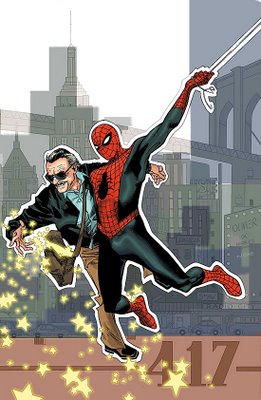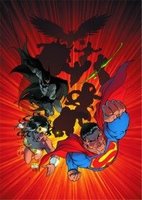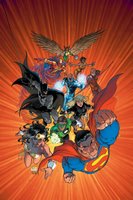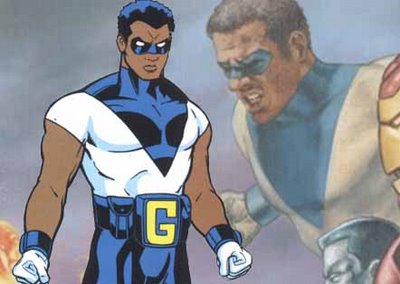 52 # 21 (DC Comics)
52 # 21 (DC Comics) The most interesting, exciting and downright alarming story about DC’s best ongoing series this week doesn’t occur within it’s covers at all. (Newsarama.com has the story on
that here,
here and
here). As for the issue itself, however, it’s got gueststars galore. Lex Luthor appropriates the old Infinity Inc. trademark (shades of Milligan’s
X-Force and John Arcudi’s
Doom Patrol), and his sickly-designed green and purple superteam take on new names and costumes, led by Natasha Irons’ Starlight. The new Infinity Inc. gives an excuse for the absolute least likely character in DC’s entire character catalogue to become a legacy character, as we get Nuklon II (Hell, the original Nulkon didn’t even like the name or that hideously dated look, and changed them both). The new team comes face to face with first the new Blockbuster (What’s this, Blockbuster III? Come one DC, not every character needs to be a legacy character!), who is busily rampaging in Las Vegas (shades of
Hulk), and then the new Teen Titans. This line-up is lead by Beast Boy and Raven, and includes an import from the Cartoon Network’s
Teen Titans-iverse, Hotspot (nee Joto), plus two rather lame Apokalyptians, Power Boy and Little Barda, and someone apparently integrated to the DCU from the
Kingdom Come-iverse, Zatarra II (who we’ll learn more of in this week’s
Teen Titans). Plus, Ralph Dibny finds a new, hardcore use for his Gingold extract, Red Tornado get a new look and we skip the secret origins for a week.
Action Comics #843 (DC) Kurt Buskiek and Fabian Nicieza’s three-part story arc may have started in as simply a place holder fill-in story, something to plug into the title while the oncoming Richard Donner and Geoff Johns super-team were still getting ready, but it turned out to be an incredibly fun Superman story. Supes’ ragtag band of superheroes—Nightwing, Firestorm II, The Veteran, Skyrocket, Livewire, Bluejay and Aquaman II—regain their powers, free their fellow meta-humans, defeat the Auctioneer and save the world. Woo hoo! I loved this weird assemblage of heroes, and some of the cameos (look, Plastic Man still exists on “New Earth!” Sweet!), but the best part by far is the cover, with it’s headline of, “Superman to aliens: We’ll smack you up!” Somehow, I just can’t imagine Superman saying “We’ll smack you up!” On a side note, another article teased on the cover reads “Entire Ohio Town Forms Human ‘S’ That Can Be SEEN FROM SPACE!” As an Ohioan, I’m curious as to which town. Anyone know where I can get a copy of this
Action tabloid, or is it only available in Metropolis?
The Amazing Spider-Man #535 (Marvel Comics) You win Marvel—I’m your bitch. Suffering crossover fatigue from following
Infinite Crisis for so long, I swore I’d read nothing but the two main
Civil War titles, and the Marvel books I was already reading that just so happened to crossover into
Civil War. But I was weak. The 90-page, four-issue reprint of
Amazing Spider-Man’s “Civil War”
tie-ins last week, plus the drama of
Civil War #4 was too much to resist, and I just had to see Spidey turn on Tony “Iron Man” Stark. Maybe it was the cover of this issue alone that made me cave and buy it—I’ve waited so long for someone to punch Iron Man in the face, that I just couldn’t resist. In this issue, written by JMS (whom I occasionally wish was writing
Civil War, as he’s been able to frame the pro-registration argument in terms that seem compelling, at least in a vague sense—the implementation, on the other hand, remain indefensible). In this issue, Peter Parker’s doubts about what side he’s on intensify, and he asks Stark to take him to the Negative Zone to investigate the prison complex captured non-registrants are forced into. He also has a conversation with Reed Richards, who explains why he’s acting like such an evil douchebag—it basically comes down to Richards agreeing that Joe McCarthy’s anti-communist witch hunts should have been complied with, and those called before HUAC should simply have rolled over for the commission, a position that Reed Richards and Ann Coulter are the last two human beings on Earth to hold. The punching in the face doesn’t really occur between these covers—the issue ends with Iron Man tackling Spidey, and flying through his own walls and endangering the lives MJ and May to do so. I was pretty surprised by this issue, in part because I thought it was the knowledge that Tony had recruited the Green Goblin to help him enforce the Superhuman Registration Act that would cause Spidey to flip, but also at how hardcore evil Tony is becoming. The N-Zone institution is like Guantanamo Bay, only worse. Guantanamo gives feds plenty of wiggle room in treating detainees because it’s not on American soil, but
this place isn’t even in the same universe as America, and these aren’t foreign nationals and/or American citizens suspected of affiliation with terrorist groups, but citizens whose only crime is not signing the equivalent of a federal draft. Their sentence? Lifetime imprisonment until they sign. Yikes. The Superhuman Registration Act makes the Patriot Act sound like the Bill of Rights.
The American Way #8 (DC/WildStorm) Now
this is a superhero civil war, complete with North vs. South tensions and racial issues at the core of the conflict. If you missed it in singles, don’t you dare miss it in trade.
Bart Simpson’s Treehouse of Horror #12 (Bongo Comics) I’m not the most faithful reader of Bongo’s
Simpsons comics; hell, at this point I’m not even a faithful watcher of
The Simpsons TV show, which seems to have peaked a decade ago. But just as it never pays to miss a Halloween episode of the show, it never pays to miss a Halloween issue of the comics, partly because the freedom of the format allows comic book creators (like TV writers) to go wilder than usual, and partly because Bongo brings in some big names to create the
Treehouses, and it’s always interesting watching these talents with such peculiar art styles of their own working in Matt Groening style; more often than not, the art and humor becomes a unique hybrid. In this issue, Kyle Baker, Terry Moore and Eric Powell take a crack at the first family of animated prime time television, and the results are well worth a read. While I’m a big fan of emu-based humor and an emu plays a big role in Powell’s story, I think I enjoyed Baker’s tale of fairy vengeance even more.
Batman #657 (DC) Wow, who knew the giant trophy Tyrannosaurus robot in the Batcave was still operational? Grant Morrison continues to weave an exciting story, as Batman brings his alleged son from a drugged night of passion with Talia al Ghul back to the cave, where he grates on Alfred’s nerves and on Robin’s bones. Artist Andy Kubert’s Batman seems heavily influenced by Jim Lee’s designs, and some panels called to mind the work of
Norm Breyfogle , still my favorite Batman artist. I particularly enjoyed Batman and Robin’s conversation about young, spoiled Damien al Ghul, and how it sounded like a couple bickering: “So tell me it’s not possible. Is it possible?…What about
us?…This doesn’t
change anything.” Kubert’s shining moment is page 20: Holy God, that’s a beautiful page. Confidential to Cassandra “Batgirl” Cain fans driven mad by DC’s “New Earth” continuity: So, if Damien al Ghul was raised and trained by the League of Assassins, but the League was decimated in “Destruction’s Daughter” and rebuilt by Cassie during the missing year, did
she raise and train Damien, or is he yet
another example of a League-trained child, of the sort Cassie claimed to believe she was the only one of in
Robin?
Black Panther #20 (Marvel) The post-nuptial “World Tour” story arc continues, and like, the first installment last month, this second chapter is a solid B effort from writer Reginald Hudlin, whose main goal for each issue seems to be to get T’Challa into a different cat-themed costume (Hudlin’s either pushing for a Black Panther action figure line, or trying to beat the Silver Age Batman for the amount of different costume’s in his hero’s closet) and bringing him to blows with a some royal super-person or another. T’Challa and Ororo take the Panther Rocket to the Blue Area of the moon to chat with Inhuman king and queen Black Bolt and Medusa, but end up fighting much of the royal family before the misunderstanding is all ironed out. The fight seems overly forced (as last month’s one with Doom was) and the Bruce Lee quote seemed odd coming from the mouth of an African royal/superhero/scientist who presumably has little time for pop culture study, but all in all, Hudlin seems pretty savvy when it comes to pumping out fun done-in-ones.
Blue Beetle #7 (DC) Wow, it really works. It’s common knowledge that Marvel will stick Wolverine or Spider-Man on any cover they possibly can to boost sales, just as DC will use Batman, but I was skeptical that it actually translated into more books moved. Well, now I’ve seen the light, having experienced it first hand. I’d tried the first issue of DC’s new
Blue Beetle, and while the writing was fine and the art was great, I never picked up #2 or any future issues. I guess I questioned the need of a legacy-for-legacy’s sake charcter like Blue Beetle III, especially since I was still so sorry to see Blue Beetle II killed off, and was unimpressed with the basic story of a young hero having a legacy thrust upon him, as I’ve read that story in several dozen other comic books. Well, this week while scanning the shelves of my local comic shop, and image of Batman’s pointy ears caught my eye, and I picked up
Blue Beetle #7. The tag “How I Survived My Infinite Crisis” (the usually wit-free tag lines on the cover of DC comics are another thing I’m incredibly skeptical of) and a flip through landed it atop my stack of books. The new Beetle Jaime and his family (okay, that
is a new twist) plus the new Peacemaker (What, Peacemaker VIII? Aaaa! Too many legacies!) gather around the divots made from issue #1’s fight with Guy Gardner, and Jaime recounts his role in
Infinite Crisis, form his perspective, allowing for guest stars like Batman, the Green Lanterns, Green Arrow and Black Canary, plus some cameos from the likes of Black Lightning and Mr. Terrific. It was a fun one-issue story, and I love Cully Hamner’s art, particularly his design of and rendering of BB’s costume, so the opportunity to see him drawing so many different DC characters was welcome. As with the #1, however, I don’t see any strong reason to pick up the next issue. At least I finally know why no one could find the Brother I sattelitte until the scarab and Jaime teamed up.
Civil War: Frontline #6 (Marvel) One issue, four stories, four different levels of quality. In “Embedded,” we see the Battle of Geffen-Meyer Chemical Plant from a different perspective, that of embedded journalist Ben Urich (Sally Floyd, meanwhile, is under arrest). Tony Stark seems even more blasé in a post-Goliath casualty interview than he did in
Civil War #4, but Urich wants to talk about the new “Thunderbolts” more than Goliath, to Stark’s consternation. In an inadvertently hilarious sight gag, first responders try covering Goliath’s gigantic corpse with a blanket, but end up needing dozens of them, and even then they’re just barely covering his face and shoulder. In “The Accused,” Speedball tells off a particularly goofy Reed Richards, and the last panel may be the single most surreally ridiculous one I’ve ever seen. “Sleeper Cell” opens with a pretty cool image, and I didn’t bother with the insulting fourth story, wherein real life military tragedies are offensively compared to Marvel’s “Civil War” crossover. This issue’s seemed to be Stark and SHEILD to Hitler and the Nazis, and you know what they say about comparing an opponent to Hitler or the Nazis—if that’s all you’ve got for rhetoric, it’s time to give up the argument. I’ll keep my fingers crossed that Paul Jenkins and Marvel will therefore give up on these back-ups in the next few issues of
Frontline, but somehow I doubt it.
Civil War: Young Avengers & Runaways #3 (Marvel) The unexpectedly large role the Young Avengers are playing in the main
Civil War book—with Patriot, Stature and Wiccan front and center for the last few issues—have rendered this particular issue a little confusing. I assume this whole series takes place
before the last issue of
Civil War, which means we have to expect that Wiccan, who gets captured by SHIELD here, will escape, only to be captured by SHIELD for a third time. Regardless of the continuity traffic copping, this was an okay read, with Morrison’s Marvel Boy handing out beatdowns to Marvel’s two premier super-teen teams. Zeb Wells’ story is devolving into simply so-so, but Stefano Caselli’s art is reason enough to finish the series. I particularly like his Old Lace, his sexy take on Nico and the edge of bad assed-ness he brings to Chase Stein and Victor Mancha. And the scene with Vision’s hand? Hardcore.
DDP Quarterly! (Devil’s Due Publishing) Among the rules of thumb I have about comics purchasing is this: Any new comic that costs a quarter or less is well worth the purchase. Even if it totally sucks, you’re probably getting your moneys worth in paper alone. So when I saw the 25-cent price tag on this new publication from DDP, the publishers of so many decent licensed comics that they could be on the verge of becoming the industry’s next Dark Horse Comics, I put it atop my stack without even flipping through it. So it made it all the way home with all of the real comic books before I flipped through it and saw that it was nothing but preview images and interviews, with not even a single sequential art story within. It was shaped like a comic book, sure, but it wasn’t a comic book. It was simply DDP hype disguised as a comic book, and, to add insult to injury, they asked us to pay to look at their advertising. Man, I’d write an angry letter to complain and ask for my money back, but the cost of a stamp greatly exceeds the cost of this publication.
Eternals #4 (Marvel) I find myself somewhat embarrassed to say I’m not loving Neil Gaiman’s next go-round with a Jack Kirby creation, but considering how
The Sandman turned out ,
The Expositionals, er,
Eternals seems like sort of a waste of everyone’s talent and time. I’m particularly annoyed by the covers, which are so different and (frankly) so much weaker than John Romita Jr.’s artwork inside. Sadly, not only is Gaiman’s new Marvel book no
Sandman, it’s not even a
1602.
Justice League of America #2 (DC) Three issues in, counting #0, and Brad Meltzer is still slowly putting the League together, at a write-for-the-trade/wait-for-the-trade pace. Of the ten heroes shown on the cover, one of them hasn’t had so much as a cameo appearance yet. Batman, Superman and Wonder Woman (Diana, not Donna; I don’t get it either) continue to look at glamour shots to determine who’s in or out; admittedly, a cool idea, although it probably need not take more than one issue. Black Lightning continues to infiltrate the villains, who Meltzer takes similar liberties with the characterization of to what he did with Catman in
Green Arrow and Captain Boomerang and Dr. Light in
Identity Crisis. Vixen fights some villains. Black Canary, Hal Jordan and Arsenal fly around. And Red Tornado has sex with his wife, and is sore afterwards (Ew!). He also puts on a costume that makes him look just like he did when he was an android; not sure how that works, exactly. If I had to offer a theory on the mystery villain pulling the strings and bossing a human-looking Dr. Ivo around, I’d guess it’s Amazo, but I hope I’m wrong, as I want more from Meltzer than the League vs. Amazo, round 2,456.
JSA: Classified #17 (DC) Tony Bedard makes a connection between the original Hourman’s Miralco drug and the Venom drug that fuels Bane. Seeking to save Santa Prisca from drug dealers, Bane does battle with the Priscan mob, loses, and is forced to assassinate Hourman I, opting instead to team up with Hourman II. The story’s nothing special, really, but the art, by Scott McDaniels, is the usual treat.
Ramayan 3392 AD #1 (Virgin Comics) I’ve grown somewhat bored with Virgin Comics already, in part because all of the titles I’m reading seem so similar (and are all so slowly paced). I couldn’t resist giving this new series a try though, based on that glorious Alex Ross painted cover alone. The science fiction-like re-telling of the Indian mythological epic reminded me, somewhat unfavorably, of
Devi and a handful of European comics of similar themes and tone, but by the time I reached the end, I was excited to see what happens next. In that respect,
Ramayan is like the rest of the company’s line—even the worst comics they put out are good enough to keep you reading.
Red Sonja: Monster Isle (Dynamite Entertainment) This oversized one shot is a nice jumping on/trying out point for barbarian comics fans who want to see what the number two name in the genre is up to these days. Writer Roy Thomas (yes,
that Roy Thomas) deposits the She-Devil with a Sword on the titular isle, which is run by a Marlon Brando look-a-like pulling a sorcerous version of Dr. Moreau’s trick. It’s not a bad read on a pot-boiling, genre level, and though artist Pablo Marcos’ work is only so-so (Sonja’s anatomy is fluid and ever-changing), he gets lots of cool monsters to draw.
Secret Six #4 (DC) The titular team’s glaring lack of raison d’etre isn’t going away, and I find myself wondering why they’re still all hanging out together and what they’ve been doing over the course of the last year, but despite this lack of foundational strength, Gail Simone’s team book remains a pretty fun read. I guess it comes down to really liking most of the characters, and Simone’s way with them (particularly her Dr. Psycho and Mad Hatter). This issue is mostly devoted to a throwdown against the new OYL Doom Patrol, which makes for some fun moments (particularly the bit with Ragdoll and Elastic Woman, and Knockout’s goodbye to Robot Man). The relish with which Psycho took to his punishment was a nice twist too. Brad Walker’s art is improving each issue as he gets a better handle on his subjects, but I think Troy Nixey’s inks look much sharper on his pencil art than Jimmy Palmiotti’s do, based on how much more snap Walker’s work had in the rather dreadful “War Games” crossover than it has here.
She-Hulk #12 (Marvel) Wow, I thought new artist Rick Burchett had hit his stride last issue, but this one is head and shoulders above #11. Little can be said about the surprising guest-star here without spoiling some of the book’s coolest surprises, so let’s just say that Shulkie is whisked away to Saturn to fulfill her cosmic duties as an objective observer of the trial for Starfox, a difficult task considering their history, recent an ancient. The plot also allows Dan Slott to get his book out of the “Civil War” mega-story for a while, and that’s a very welcome development, considering Shulkie is apparently on the (clearly) wrong side of the debate at this point.
Snake Woman #3 (Virgin) One more baby ssstep forward, as Jesssica learnsss a little more about her passst, and the Bad Guy shows up to confront her.
Stan Lee Meets the Amazing Spider-Man #1 (Marvel) I hate to be a cynical young comic book reader, and I
do understand the man’s hard to overestimate impact on the comic industry and medium (he did create the Marvel Universe with a handful of artists and re-create the American superhero, influencing every single superhero comic to follow), but over the past few years the name Stan Lee has become more of a logo or brand name to me than the name of an honest-to-God comic book writer. Well, a read of his contribution to this quirky work disabused me of that notion. He may have long since entered into the elder statesmen era of hiscomics career, but Stan has still got it. The wacky concept of this book was all it took to convince me to pick it up, and I’m glad I did. The first story, penned by Stan Lee (who’s credit sequence shows no matter how many times you may have seen an homage to or parody of Lee credits, no one does ‘em like he does—“pluperfectly,” ha!), is about Spidey swinging by to ask for some advice from his creator and father figure. Lee sets it up as the perfect excuse for a speech on the importance of heroes, and then switches it up with a punchline too good to spoil. Olivier Coipel’s Romita-esque pencils don’t hurt none, either. The next story, by Joss Whedon and Michael Gaydos, is about an interdimensional comic book convention, which has fun with the concept of parallel versions of the same person comparing notes, and shies away from Lee until the end, where Whedon makes the predictable “There’s only one Stan Lee” comment, but saves room for a porn joke. Perfect. And if that still wasn’t enough comics for you, the back up is an apparently re-colored (as it looks much better than anything from that era) Spidey story by Lee and John Romita, whose work here shows all us young whippersnappers where John Romita Jr. inherited his name and talent (if not his style). Somewhat surprisingly, this was probably the most satisfying read in a huge week of releases.
Teen Titans #39 (DC) Tony S. Daniel returns to art chores for the second chapter of “Titans Around the World,” a round-the-world search for a missing member that makes for a pleasant story arc. We meet three more Titans from the missing year this issue (one of whom was also in this week’s
52--now that’s synergy!). The first is Zatara, the never-before-mentioned cousin of Zatanna who has her fathers name and gained powers similar to his namesake and cousin “during that whole mess with the Spectre” (I’m guessing it had something to do with the Rock of Eternity explosion?). His appearance is a bit of a letdown given the fact that DC readers were led to believe he came to our dimension during
Infinite Crises’s multiverse re-jiggering (Offspring, Batman’s son and a new Starman, all of whom appeared in the
Kingdom Come-iverse previously, have also been sighted in the modern DCU). It’s also a little underwhelming. While his appearance, like that of Miss Martian (a teenage J’onn J’onnz) and Bombshell (a teenage Captain Atom) may make for an interesting few pages of a story arc like this, none are very inspired creations, and none really add anything interesting to the fabric of the DCU. As for M.M., how a green martian other than J’onn J’onnz is on earth is explained, though why she’s adopted a Sailor Moon (Sailor Mars?), Japanese school girl look, despite the fact that she lives in Australia, isn’t. Confidential to Plastic Man fans disappointed by the thought of their hero as a deadbeat dad: There’s another hint that the new Offspring character isn’t from the
Kingdom Come-iverse either, but is actually the out of wedlock, long-ignored son of Plastic Man that Joe Kelly introduced during his
JLA run and Kyle Baker erased from continuity in his
Plastic Man.
The Ultimates 2 #12 (Marvel) It’s finally here! The long, long, long, long awaited conclusion to Mark Millar and Bryan Hitch’s
Ultimates 2, the latest book in the world, arrives this week with an oversized chapter appropriately entitled “The Avengers.” But what’s this? We actually have one more chapter to go, as Millar and Hitch just had way too much story for 12 issues. Oh well, I guess we’ll just have to wait another four to six months for that (In the meantime, we can look forward to enjoying
Ultimate Wolverine vs. Hulk #3…sigh). While it’s hard to utter the words “worth the wait” during waits this long, this book has never once disappointed, and in this issue we see the Ultimates not only kicking ass, but killing ass, like the soldiers they are. Watching the Hulk pound the Liberators into the ground is to be expected (I loved his dialogue, by the way, even if he seems a tad calmer than he did in the first volume), but I was a little surprised at how harshly Quicksilver and the Wasp—not to mention a completely smashed Tony Stark--dealt with their opponents, and particularly the lack of mercy Captain America showed his fallen opponent. This title couldn’t get much more over the top without a Max label, which makes it the perfect fusion of PG 13-rated summer blockbuster and Marvel comics, as it was intended to be. If I were Jeph Loeb, slated to follow this series up with
Ultimates 3 and
Ultimates 4, I’d probably be crying myself to sleep every night.
Ultimate Spider-Man #100 (Marvel) The good thing about a creative team sticking with a single title this long is that it allows them to build up vast amounts of momentum when they want to hit you with the sort of revelation they do in this issue (this is a story that was literally 100 issues and years in the making). The bad thing about a creative team sticking with a single title this long is that it makes it awfully hard for people like me to think of new ways to say how amazingly awesome it is. I mean, how many times can you say
Ultimate Spider-Man is the very best ongoing superhero comic book on the market before it starts to lose meaning? Ah well, I ‘ll say it one more time, and then excuse myself to go scour Mark Bagley’s sketchbook section for clues into possible future storylines.
Uncle Sam and the Freedom Fighters #3 (DC) DC’s FF heads out west to recruit the new Black Condor (if Geoff Johns would have merely wounded rather than killed Black Condor II, it would have saved them the trip), who, like the last one, is a Native American granted mystical powers to save his people from the white man back in the 19th Century. The bit about teaming up with the spirit of the country was interesting, and artist Daniel Acuna has certainly busted out a super-cool character design for Black Condor III, but I’m having some trouble seeing what’s so incredibly different about BC III that it dictated the creation of another generation in the legacy of such a minor character. The rest of the issue is devoted to the FF fighting superheroes from their former employers, all sporting the lamest names you could imagine for a group of evil, government-sponsored superheroes—Chief Justice, Spin Doctor, Propaganda and Embargo. Together, they are First Strike (snicker!). Acuna does something different with his art here, and I think I like it better (the characters lose some of the plasticity they had in previous issues), but I’m not sure if the third issues in an eight-part miniseries is the best place to experiment with new styles. Now, what the hell was Jonah Hex doing in the third panel, I wonder?
*I take it back, I suppose you could imagine worse names for a group of evil, government-sponsored superheroes, like Killer Flag, The Reclublican, The Demolition-crat and the Spirit of Seventeen Seventy-Kix. Those names are lamer. Well, a little lamer.
Wonderland #2 (Slave Labor Graphics) Like
Haunted Mansion, this unlikely collaboration between Disney and indie publisher SLG is surprisingly high-quality, and I enjoyed the second issue every bit as much as the first, for much the same reason. Writer Tommy Kovac is able to ground his story in the works of Lewis Carroll
and the Disney film without ever striking a single discordant note, and it’s a treat to see artist Sonny Liew’s stylistic take on Disney’s stylistic take on the original John Tenniel designs. At last count, there were somewhere around fourteen thousand comic books set in or around the worlds that Carrol created, but this far,
Wonderland seems to be the best.
Zombie #1 (Marvel) Okay, I have something of a rule when it comes to zombie comics. There are so damn many of them that, at this point, they need to have either a seriously interesting hook or some seriously awesome artwork to justify their existence (let alone a purchase). I let this book off the hook, however, as it’s the first new, non-Punisher book on Marvel’s Max imprint in a long, long time, and I’ve yet to read a
bad Max comic (Think Bendis’
Alias, or Ennis’
Punisher books,
Fury or
Thor: Vikings). Well, Kyle Hotz’s art is pretty cool, but not cool enough for another tour of
Night of the Living Dead Homage Land. The book starts with a bank robbery, complete with hostages, gone horribly wrong, when the robbers drive into a zombie apocalypse. The first issue cliffhanging ending, in which our surviving protagonists get ready to hole up in a fortified building for an impeding zombie siege, was simply a scene I’ve seen way to many times.
Zombie #2, I just don’t think I’ll be reading you.
















